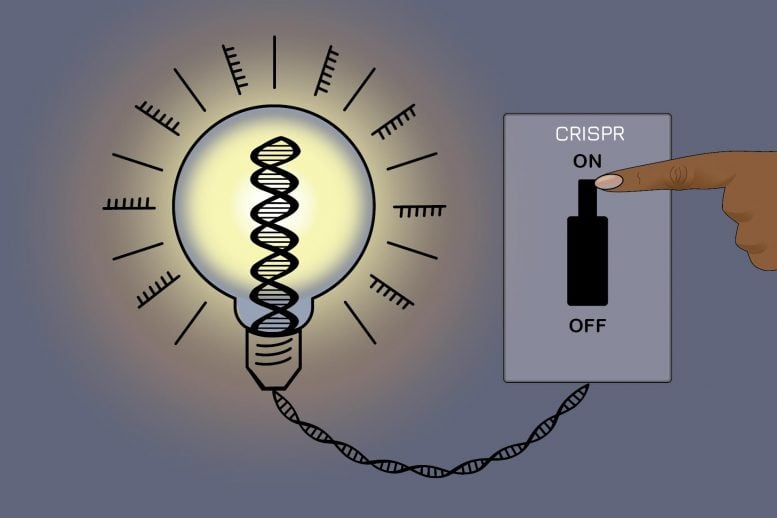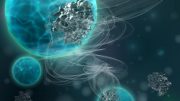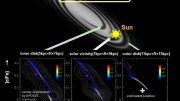
A new CRISPR method allows researchers to silence most genes in the human genome without altering the underlying DNA sequence — and then reverse the changes. Credit: Jennifer Cook-Chrysos/Whitehead Institute
New, reversible CRISPR method can control gene expression while leaving underlying DNA sequence unchanged.
Over the past decade, the CRISPR-Cas9 gene editing system has revolutionized genetic engineering, allowing scientists to make targeted changes to organisms’ DNA. While the system could potentially be useful in treating a variety of diseases, CRISPR-Cas9 editing involves cutting DNA strands, leading to permanent changes to the cell’s genetic material.
Now, in a paper published online in Cell on April 9, researchers describe a new gene editing technology called CRISPRoff that allows researchers to control gene expression with high specificity while leaving the sequence of the DNA unchanged. Designed by Whitehead Institute Member Jonathan Weissman, University of California San Francisco assistant professor Luke Gilbert, Weissman lab postdoc James Nuñez and collaborators, the method is stable enough to be inherited through hundreds of cell divisions, and is also fully reversible.
“The big story here is we now have a simple tool that can silence the vast majority of genes,” says Weissman, who is also a professor of biology at MIT and an investigator with the Howard Hughes Medical Institute. “We can do this for multiple genes at the same time without any DNA damage, with great deal of homogeneity, and in a way that can be reversed. It’s a great tool for controlling gene expression.”
The project was partially funded by a 2017 grant from the Defense Advanced Research Projects Agency to create a reversible gene editor. “Fast forward four years [from the initial grant], and CRISPRoff finally works as envisioned in a science fiction way,” says co-senior author Gilbert. “It’s exciting to see it work so well in practice.”
Genetic engineering 2.0
The classic CRISPR-Cas9 system uses a DNA-cutting protein called Cas9 found in bacterial immune systems. The system can be targeted to specific genes in human cells using a single guide RNA, where the Cas9 proteins create tiny breaks in the DNA strand. Then the cell’s existing repair machinery patches up the holes.
Because these methods alter the underlying DNA sequence, they are permanent. Plus, their reliance on “in-house” cellular repair mechanisms means it is hard to limit the outcome to a single desired change. “As beautiful as CRISPR-Cas9 is, it hands off the repair to natural cellular processes, which are complex and multifaceted,” Weissman says. “It’s very hard to control the outcomes.”
That’s where the researchers saw an opportunity for a different kind of gene editor — one that didn’t alter the DNA sequences themselves, but changed the way they were read in the cell.
This sort of modification is what scientists call “epigenetic” — genes may be silenced or activated based on chemical changes to the DNA strand. Problems with a cell’s epigenetics are responsible for many human diseases such as Fragile X syndrome and various cancers, and can be passed down through generations.
Epigenetic gene silencing often works through methylation — the addition of chemical tags to to certain places in the DNA strand — which causes the DNA to become inaccessible to RNA polymerase, the enzyme which reads the genetic information in the DNA sequence into messenger RNA transcripts, which can ultimately be the blueprints for proteins.
Weissman and collaborators had previously created two other epigenetic editors called CRISPRi and CRISPRa — but both of these came with a caveat. In order for them to work in cells, the cells had to be continually expressing artificial proteins to maintain the changes.
“With this new CRISPRoff technology, you can [express a protein briefly] to write a program that’s remembered and carried out indefinitely by the cell,” says Gilbert. “It changes the game so now you’re basically writing a change that is passed down through cell divisions — in some ways we can learn to create a version 2.0 of CRISPR-Cas9 that is safer and just as effective, and can do all these other things as well.”
Building the switch
To build an epigenetic editor that could mimic natural DNA methylation, the researchers created a tiny protein machine that, guided by small RNAs, can tack methyl groups onto specific spots on the strand. These methylated genes are then “silenced,” or turned off, hence the name CRISPRoff.
Because the method does not alter the sequence of the DNA strand, the researchers can reverse the silencing effect using enzymes that remove methyl groups, a method they called CRISPRon.
As they tested CRISPRoff in different conditions, the researchers discovered a few interesting features of the new system. For one thing, they could target the method to the vast majority of genes in the human genome — and it worked not just for the genes themselves, but also for other regions of DNA that control gene expression but do not code for proteins. “That was a huge shock even for us, because we thought it was only going to be applicable for a subset of genes,” says first author Nuñez.
Also, surprisingly to the researchers, CRISPRoff was even able to silence genes that did not have large methylated regions called CpG islands, which had previously been thought necessary to any DNA methylation mechanism.
“What was thought before this work was that the 30 percent of genes that do not have a CpG island were not controlled by DNA methylation,” Gilbert says. “But our work clearly shows that you don’t require a CpG island to turn genes off by methylation. That, to me, was a major surprise.”
CRISPRoff in research and therapy
To investigate the potential of CRISPRoff for practical applications, the scientists tested the method in induced pluripotent stem cells. These are cells that can turn into countless cell types in the body depending on the cocktail of molecules they are exposed to, and thus are powerful models for studying the development and function of particular cell types.
The researchers chose a gene to silence in the stem cells, and then induced them to turn into nerve cells called neurons. When they looked for the same gene in the neurons, they discovered that it had remained silenced in 90 percent of the cells, revealing that cells retain a memory of epigenetic modifications made by the CRISPRoff system even as they change cell type.
They also selected one gene to use as an example of how CRISPRoff might be applied to therapeutics: the gene that codes for Tau protein, which is implicated in Alzheimer’s disease. After testing the method in neurons, they were able to show that using CRISPRoff could be used to turn Tau expression down, although not entirely off. “What we showed is that this is a viable strategy for silencing Tau and preventing that protein from being expressed,” Weissman says. “The question is, then, how do you deliver this to an adult? And would it really be enough to impact Alzheimer’s? Those are big open questions, especially the latter.”
Even if CRISPRoff does not lead to Alzheimer’s therapies, there are many other conditions it could potentially be applied to. And while delivery to specific tissues remains a challenge for gene editing technologies such as CRISPRoff, “we showed that you can deliver it transiently as a DNA or as an RNA, the same technology that’s the basis of the Moderna and BioNTech coronavirus vaccine,” Weissman says.
Weissman, Gilbert, and collaborators are enthusiastic about the potential of CRISPRoff for research as well. “Since we now can sort of silence any part of the genome that we want, it’s a great tool for exploring the function of the genome,” Weissman says.
Plus, having a reliable system to alter a cell’s epigenetics could help researchers learn the mechanisms by which epigenetic modifications are passed down through cell divisions. “I think our tool really allows us to begin to study the mechanism of heritability, especially epigenetic heritability, which is a huge question in the biomedical sciences,” Nuñez says.
Reference: “Genome-wide programmable transcriptional memory by CRISPR-based epigenome editing” by James K. Nuñez, Jin Chen, Greg C. Pommier, J. Zachery Cogan, Joseph M. Replogle, Carmen Adriaens, Gokul N. Ramadoss, Quanming Shi, King L. Hung, Avi J. Samelson, Angela N. Pogson, James Y.S. Kim, Amanda Chung, Manuel D. Leonetti, Howard Y. Chang, Martin Kampmann, Bradley E. Bernstein, Volker Hovestadt, Luke A. Gilbert and Jonathan S. Weissman, 9 April 2021, Cell.
DOI: 10.1016/j.cell.2021.03.025









This could help conditions like mine (CMT1A) which is caused by a gene over-expression.
Babu G. Ranganathan*
(B.A. Bible/Biology)
HOW DOES DNA TURN A CELL INTO A SHEEP, OR A BIRD, OR A HUMAN?
When you divide a cake, the cake never gets bigger. However, when we were just a single cell and that cell kept dividing we got bigger. New material had to come from somewhere. That new material came from food.
Just as the sequence of various letters and words in human language communicate a message and direct workers to build and assemble something so, too, the sequence of various molecules in our DNA (our genes or genetic code) directed the molecules from our mother’s food, that we received in the womb, to become new cells, eventually forming all the tissues and organs of our body.
When you feed a cat your food the cat’s DNA will direct the food molecules to become the cells, tissues, and organs of a cat, but your DNA will turn the same food into human cells, tissues, and organs.
What we call “genes” are actually segments of the DNA molecule. When you understand how your DNA works, you’ll also understand how egg yolks can turn into chickens. Read my popular Internet article: HOW DID MY DNA MAKE ME? Just google the title to access the article.
This article will give you a good understanding of how DNA, as well as cloning and genetic engineering. You also learn that so-called “Junk DNA” isn’t junk at all. You will learn why it is not rational to believe that DNA code could have arisen by chance. Science points (not proves, but points) to an intelligent cause for DNA code.
What about genetic and biological similarities between species? Genetic information, like other forms of information, cannot happen by chance, so it is more logical to believe that genetic and biological similarities between all forms of life are due to a common Designer who designed similar functions for similar purposes. It doesn’t mean all forms of life are biologically related! Only genetic similarities within a natural species proves relationship because it’s only within a natural species that members can interbreed and reproduce.
Nature cannot build DNA code from scratch. It requires already existing DNA code to direct and bring about more DNA code or a genetic engineer in the laboratory using intelligent design and highly sophisticated technology to bring DNA code into existence from scratch. Furthermore, RNA/DNA and proteins are mutually dependent (one cannot come into existence without the other two) and cannot “survive” or function outside of a complete and living cell. DNA code owes its existence to the first Genetic Engineer – God!
Protein molecules require that various amino acids come together in a precise sequence, just like the letters in a sentence. If they’re not in the right sequence the protein won’t function. DNA and RNA require for various their various nucleic acids to be in the right sequence.
Furthermore, there are left-handed and right-handed amino acids and there are left-handed and right-handed nucleic acids. Protein molecules require for all their amino acids to be left-handed only and in the right sequence. DNA and RNA require for all their nucleic acids to be right-handed and in the right sequence. It would take a miracle for DNA, RNA, and proteins to arise by chance!
Mathematicians have said any event in the universe with odds of 10 to 50th power or greater is impossible! The probability of just an average size protein molecule (with its amino acids in the right sequence) arising by chance is 10 to the 65th power. Even the simplest cell is made up of many millions of various protein molecules along with and DNA/RNA..
The late great British scientist Sir Frederick Hoyle calculated that the odds of even the simplest cell coming into existence by chance is 10 to the 40,000th power! How large is this? Consider that the total number of atoms in our universe is 10 to the 82nd power.
Also, so-called “Junk DNA” isn’t junk. Although these “non-coding” segments of DNA don’t code for proteins, they have recently been found to be vital in regulating gene expression (i.e. when, where, and how genes are expressed, so they’re not “junk”). Also, there is evidence that, in certain situations, they can code for proteins through the cell’s use of a complex “read-through” mechanism.
Visit my latest Internet site: THE SCIENCE SUPPORTING CREATION (This site answers many arguments, both old and new, that have been used by evolutionists to support their theory)
Author of the popular Internet article, TRADITIONAL DOCTRINE OF HELL EVOLVED FROM GREEK ROOTS
*I have given successful lectures (with question and answer period afterwards) defending creation before evolutionist science faculty and students at various colleges and universities. I’ve been privileged to be recognized in the 24th edition of Marquis “Who’s Who in The East.”
This sounds like it could lead to a cure for the rare fatal genetic disease that my grandson has. He is 6 years old and has GM1 type 2. Please get all the links worked out. And cure these precious children of ours. Prayers science cones through for us asap before we lose my grandson.
Can this technology be used to make Vaccines hopefully without any side effects — such as a 100% Successful Side Effect Free Covid19 Vaccine!?